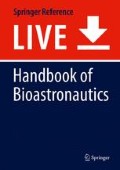References
Barger LK, Sullivan JP, Vincent AS, Fiedler ER, McKenna LM, Flynn-Evans EE, Gilliland K, Sipes WE, Smith PH, Brainard GC, Lockley SW (2012) Learning to live on a Mars day: fatigue countermeasures during the Phoenix Mars Lander mission. Sleep 35:1423–1435
Basner M, Dinges DF, Mollicone D, Ecker A, Jones CW, Hyder EC, Di Antonio A, Savelev I, Kan K, Goel N, Morukov BV, Sutton JP (2013) Mars 520-d mission simulation reveals protracted crew hypokinesis and alterations of sleep duration and timing. Proc Natl Acad Sci U S A 110:2635–2640
Booth V, Behn CGD (2014) Physiologically-based modeling of sleep–wake regulatory networks. Math Biosci 250:54–68
Breslow ER, Phillips AJK, Huang JM, St. Hilaire MA, Klerman EB (2013) A mathematical model of the circadian phase-shifting effects of exogenous melatonin. J Biol Rhythms 28:79–89
Daan S, Beersma DG, Borbély AA (1984) Timing of human sleep: recovery process gated by a circadian pacemaker. Am J Physiol 246:R161–R183
Dean DA, Forger DB, Klerman EB (2009) Taking the lag out of jet lag through model-based schedule design. PLoS Comput Biol 5:e1000418
Duffy JF, Czeisler CA (2009) Effect of light on human circadian physiology. Sleep Med Clin 4:165–177
Duffy JF, Cain SW, Chang AM, Phillips AJK, Münch MY, Gronfier C, Wyatt JK, Dijk DJ, Wright KP, Czeisler CA (2011) Sex difference in the near-24-hour intrinsic period of the human circadian timing system. Proc Natl Acad Sci U S A 108:15602–15608
Forger DB, Jewett ME, Kronauer RE (1999) A simpler model of the human circadian pacemaker. J Biol Rhythms 14:533–538
Gooley JJ, Rajaratnam SM, Brainard GC, Kronauer RE, Czeisler CA, Lockley SW (2010) Spectral responses of the human circadian system depend on the irradiance and duration of exposure to light. Sci Transl Med 2:31ra33
Gronfier C, Wright KP, Kronauer RE, Czeisler CA (2007) Entrainment of the human circadian pacemaker to longer-than-24-h days. Proc Natl Acad Sci U S A 104:9081–9086
Guo JH, Qu WM, Chen SG, Chen XP, Lv K, Huang ZL, Wu YL (2014) Keeping the right time in space: importance of circadian clock and sleep for physiology and performance of astronauts. Mil Med Res 1(1):23
Jewett ME, Kronauer RE (1999) Interactive mathematical models of subjective alertness and cognitive throughput in humans. J Biol Rhythms 14:588–597
Khalsa SBS, Jewett ME, Cajochen C, Czeisler CA (2003) A phase response curve to single bright light pulses in human subjects. J Physiol 549:945–952
Klerman EB, Dijk DJ, Kronauer RE, Czeisler CA (1996) Simulations of light effects on the human circadian pacemaker: implications for assessment of intrinsic period. Am J Physiol 270:R271–R282
Kronauer RE, Forger DB, Jewett ME (1999) Quantifying human circadian pacemaker response to brief, extended, and repeated light stimuli over the phototopic range. J Biol Rhythms 14:501–516
Postnova S, Layden A, Robinson PA, Phillips AJK, Abeysuriya RG (2012) Exploring sleepiness and entrainment on permanent shift schedules in a physiologically based model. J Biol Rhythms 27:91–102
Puckeridge M, Fulcher BD, Phillips AJK, Robinson PA (2011) Incorporation of caffeine into a quantitative model of fatigue and sleep. J Theor Biol 273:44–54
Robinson PA, Phillips AJK, Fulcher BD, Puckeridge M, Roberts JA (2011) Quantitative modelling of sleep dynamics. Philos Trans A Math Phys Eng Sci 369:3840–3854
Serkh K, Forger DB (2014) Optimal schedules of light exposure for rapidly correcting circadian misalignment. PLoS Comput Biol 10:e1003523
Wever R (1979) The circadian system of man: results of experiments under temporal isolation. Springer, New York
Author information
Authors and Affiliations
Corresponding author
Editor information
Editors and Affiliations
Section Editor information
Rights and permissions
Copyright information
© 2019 Springer Nature Switzerland AG
About this entry
Cite this entry
Klerman, E.B., Phillips, A.J.K. (2019). Modeling and Entraining Human Capability in Space. In: Young, L., Sutton, J. (eds) Encyclopedia of Bioastronautics. Springer, Cham. https://doi.org/10.1007/978-3-319-10152-1_32-1
Download citation
DOI: https://doi.org/10.1007/978-3-319-10152-1_32-1
Received:
Accepted:
Published:
Publisher Name: Springer, Cham
Print ISBN: 978-3-319-10152-1
Online ISBN: 978-3-319-10152-1
eBook Packages: Springer Reference EngineeringReference Module Computer Science and Engineering
Publish with us
Chapter history
-
Latest
Modeling and Entraining Human Capability in Space- Published:
- 20 November 2020
DOI: https://doi.org/10.1007/978-3-319-10152-1_32-2
-
Original
Modeling and Entraining Human Capability in Space- Published:
- 26 November 2018
DOI: https://doi.org/10.1007/978-3-319-10152-1_32-1

